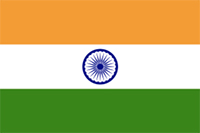

 印度
印度 印度→瑞诗凯诗→瑜伽游学
印度→瑞诗凯诗→瑜伽游学1.学校简介
Shiva Yoga Peeth座落于印度瑞诗凯诗,提供瑜伽联盟认证的200小时瑜伽教师培训和500小时瑜伽教师培训课程。
通过遵循古老的瑜伽传统,Shiva Yoga Peeth己经成为了一个为世界各地研修者提供灵性和瑜伽哲学的卓越瑜伽中心。该学校的心灵和瑜伽活动使全球数千人受益。我校一直与相关组织的人员在瑜伽和瑜伽相关科学方面进行研究工作。
Shiva Yoga Peeth提供瑜伽各种类型的瑜伽教师培训课程。 精心设计的课程结构可帮助学生学习和练习古代瑜伽哲学中定义的一些放松技巧。我们的瑜伽教师培训课程的教师是 Swami Sudhir,他拥有来自许多不同国家的广泛的瑜伽知识,且一直在不断提高他的知识结构水平。Swami Sudhir还撰写了有关改善他人基本瑜伽技能的书籍。
瑜伽教师培训课程的有效性和学生的进步是基于每个人的身体和智力以及学生的生活水平。为了帮助每个学生的成功,Shiva Yoga Peeth提供良好的住宿,根据气候所需的各种设施,并要求学生在课程期间全身心投入并遵守瑜伽教学的所有准则和规定。
住所
在我们的瑜伽教师培训课程中,我们为学生提供干净的房间,床上用品和附带西式厕所的冷热水。我们很高兴地说,现在我们已经为我们的瑜伽教师培训学生提供了一个学习园地。因此,从现在开始,我们的学生都不用留宿酒店,每个人都会住在宽敞的舒适客房里,我们共拥有83间客房且与我们的主教学楼相邻。我们的两个ashrams位于母亲甘加银行。因此,每个学生都可以有幸感受到母亲甘加的能量并获得幸福。
As a center of learning, we have boundaries and criteria with specific rules and regulations.
All students are advised to follow our rules and regulations during the course.
Every student is requested to fulfill the registration formalities and submit the required information and course fee before the starting of the course.
Students can pay in Indian Rupees or in Dollars , Euros or Pounds.
All questions in class must be related to the course syllabus.
It is beneficial to the student not to engage in poses such as shoulder stands, head stands, viparitakarani and kapalbhati, uddiyan bandha, etc. during monthly period time.
All students are instructed to come to the class at least 5 minutes before the scheduled timing of each class.
All Teacher Training students are requested not to join in any other educational or hobby programs during their course with Shiva Yoga Peeth.
Every student is requested to strictly follow the diet & guidelines as suggested by School. This is to help you gain the best experience possible.
Please avoid spicy, non-veg meals outside of the course, as this is strictly not allowed within the ashram for the duration of the course. Students need to have only Sattvik food.
We follow ancient yoga approach in ashram so the TTC is designed in such a way that the ethical practices are ingrained automatically in students. We follow the ancient “Gurukul System”.
You will find the fundamental difference in the understanding of the yogic path at Shiva Yoga Peeth. So the traditional teachings will differ from that of the West. After all, that is why you came to India right, to learn the traditional aspects of yoga.
Decent and dignified behaviour is expected from all the students. Loud speaking, uttering indecent words, smoking and alcohol is strictly prohibited inside the school premises.
Regularity and punctuality is to be maintained strictly. Discipline is an integral part of the training program.
All students have to follow the discipline of Shiva Yoga Peeth to fully experience the yogic way of living. Any kind of misbehavior with other students or teachers will be firmly assumed as breaking the code of conduct of our institution.
The effectiveness of the course and the progress of students is based on the physical and intellectual capability of each individual as well as the standard of living of students. Hence, students should be fully devoted and obey all guidelines and disciplines of the yogic path.
Any assistance which is needed by students will be discussed and offered, if possible.
Please, use your class time efficiently and save all personal discussions for your spare time.
At Shivayogapeeth – We respect all religions. However, religious discussions in a comparative way are not allowed in the institution as this may interfere with your yoga practice.
Have an open mind and open heart. You are coming to a different country. The culture will be different, the people will be different. Please have an open mind set and accept the changes. Remember that the magic happens outside of your comfort zone. An intensive training is challenging both physically and mentally. Muscles you’ve never used before might scream at you. You might find yourself suddenly crying for no apparent reason in the middle of morning meditation. It happens because of the toxins which are released from the body. Whatever you experience, be they physical, mental or spiritual, keep an open heart. Give yourself compassion, and permission to feel how you feel.
When you enrol for our TTC, you affirm that you abide and comply these rules with full knowledge and understanding.
2.课程介绍
200 hour Yoga Teacher Training in Rishikesh, India
The 200 hour Yoga Teacher Training in Rishikesh, India at Shiva Yoga Peeth in Rishikesh, India is intended for people with a great skill development interest that are looking to explore it. The course touches each area of yoga and is led by instructors with a solid knowledge of yoga who use their time to present accurate yogic theory. Completing this program will be an incredible metamorphosis for you. The courses included in the program will strengthen your own practice allowing you to use your own experience to start teaching others with confidence.
Traditional Hatha 200 hour Yoga Alliance certified teacher training program
Shiva Yoga Peeth is a registered organization by Government of India, Yoga Alliance International and Yoga Alliance USA. This is a world class training institute perfect for both yoga beginners looking to improve their health, happiness, peace and harmony and for those who want to acquire yoga as profession. After successfully completing the Yoga Teacher Training program, the certificate provided is valid all over the world for you to begin your new calling!
Objective of 200 hour Yoga teachers course
The main objective of our courses is to allow you to develop a self-practice both spiritually and physically in each of the areas listed below. The modules are categorized into 5 areas:
Practice
Anatomy and Physiology of Yogic Practices
Yoga Philosophy
Yogic Lifestyle
Teaching Methodology and Practice
As you develop your spiritual and physical practice, Teaching Methodology then assists you teach what you yourself are practising. We firmly believe that being a strong practitioner in each of these will give you the grounding and foundations to becoming a successful and confident yoga teacher. Take your first step into something that can change your life. In one month, you’ll finish this training with the necessary tools, skills and insights, to guide you on your journey.
One of the things that’s so rewarding about these 200hr intensives, is that each one of us comes to the mat for something different. Our journey is unique to ourselves, yet for 30 days we learn and grow together, become part of the same energy. You will learn to create flows for a variety of class types. Explore what works best for your body. This course offers a complete study of the eight limbs of yoga based upon the Yoga Sutras. Our training is devoted to helping Yoga Teachers teach to all walks of life. Our motto is “yoga for all” Our asana technique explores contemporary principles of alignment and safety, while honoring our students’ need for creativity, freedom, and self-expression in their practice.
Practice
1) Asanas (Postures): You will learn Many postures of Ashtanga, Iyengar, and Hatha Yoga.
Study various asanas and the technique of teaching the postures, the benefits of each posture, modifications, contraindications, and the use of props.
Standing poses.
Sitting poses, forward bends and hip openers.
Sitting/supine twists.
Back bends.
Inversions.
Arm balances.
Restorative postures.
2) Adjustment: Learn how to adjust these asanas and understand how adjustment can deepen your practice.
3) Pranayama (Breathing Techniques): These are based on traditional yogic breathing techniques which will benefit your yoga practice as you learn how to lengthen your breath. How to incorporate breathing into postures and into your classes. How breath work assists the body.
4) Shatkarma (Cleansing Techniques): These yogic cleansing practices will be integrated into the daily morning schedule and will work in conjunction with the asana practices. These will purify the nervous system and allow your breath to flow freely throughout the body. In expelling toxins from the body, we therefore cleanse it.
5) Yogic Mudras (Energy Seals): Stimulate different parts of the body by sealing in the energy. These are usually used in Pranayama and affect the flow of prana.
6) Bandhas (Energy Locks): How they regulate the flow of energy and assists the practitioner in asana.
7) Meditation: You will cover a range of meditation techniques that will help build concentration and focus in your daily practice. Techniques include Om Chanting, Chakra, candlelight Meditation.
8) Mantras (Chanting): A range of mantras will be taught including the Gayatri Mantra and many more. Find your inner harmony in these sessions.
Anatomy
You will learn anatomy relevant to yoga in order to strengthen the classroom explanations, cues, and corrections of asanas.
Yoga and Skeletal System, Brain & Nervous System, Respiratory System, Digestive System, Cardiovascular System.
Effects of kriya, Pranayama, Asanas and Meditation for various disorders.
Subtle Body Anatomy of the chakras, nadis and the application of chakras energy in the practice of Yoga.
Introduction to Ayurveda & Yogic Diet.
Yoga Philosophy
This class will focus on introducing you to the basic philosophy, concepts and history of yoga. It will cover the various traditional philosophies and viewpoints, insights from modern research and ways in which the essence of this holistic life-view can be integrated into a modern lifestyle.
Yoga Sutras (Preface of Patanjali’s yoga Sutra): Study this important text based on the 8 limbs of Ashtanga Yoga. Discover the theory and foundations of yoga as Patanjali describes how to make a connection with the body, mind and spirit.
Kriya Yoga a methodology to overcome Panch-klesha (5 causes of pain and miseries)
Raj yoga and Hatha yoga
Teaching Methodology and Practice
Class Observation: You will observe a Class given by one of our experienced yoga teachers as inspiration for the class that you will then prepare.
Teaching Methodology: This class will give you the necessary building blocks to devise your own yoga class. Learn how to motivate your students by teaching inclusively to the range of abilities that you may be faced with.
Peer Teaching: These sessions allow you to practice your teaching skills and get constructive feedback from both your Senior Teachers and your peers on your progress.
Adjustment: Learn how to help your students get deeper into a posture through adjustment.
Studying yoga lifestyle and the ethics of a yoga teacher
Studying the attitude and presence of the teacher
The seat of yoga teacher/teaching as service/why we teach/creating a sacred space
Ethical guidelines for the student teacher relationship
Creating a class/Sequencing/General teaching points
Elements of great teaching.
Classroom organization and set up.
Creating a class plan.
Teaching progressively focusing on alignment principles.
The basic principles of sequencing.
Yoga Teaching Practicum
Practicing teaching with RYT/ERYT.
Karma yoga.
Receiving/giving feedback.
Group teaching during class hours.
4 Week Curriculum – 200 Hour Yoga Teacher Training
1.Asana7. Teaching Practice
2.Pranayama8. Anatomy and Physiology of Yogic Practice
3.Meditation9. Yogic Philosophy
4.Cleansing Processes10. Hatha Yoga Pradipica
5.Bandhas11. Mantra Recitation
6.Mudras
Syllabus of Yoga Courses
A. Hatha Yoga Asanas
1.Parshvava Chakrasana – Sidebending Pose 37.Ardhmatsyendrasan – Half Fish Lord Pose
2.Tadasan A & B – Palm Tree Pose A & B 38.Shirshasan – Head Stand Pose
3.Vrikshasan – Tree Pose 39.Ardha Chandrasan – Half Moon Pose
4.Utkatasan – Chair Pose 40.Majariasana – Cat and Cow Pose
5.Trikonasan – Triangle Pose 41.Uthitha Parsvakonasan – Extended Side Angle
6.Padahastasan – Hands to Feet Pose 42.Parshvaottanasana – Intense Side Stretch
7.Garudhasan – Eagle Pose 43.Halasana – Plow Pose
8.Natarajasan – Shiva Dancing Pose 44.Chakrasana – Wheel Pose
9.Shirsha Padangushthasan – Head to Big Toe Pose 45.Karnpidhasan – Knee to Ear
10.Parivatrita Trikonasan – Reverse Triangle Pose 46.Crocodile Practices (4 Variations)
11.Uttanpadasan – Raising Feet Pose 47.Yoga Mudra B
12.Ardha Pavanmuktasan – Half Gas Release Pose 48.Gomukhasana – Cow Face Pose
13.Pavanmuktasan – Gas Release Pose 49.Poorna Matsyendrasana – Full Fish Lord Pose
14.Viprit Karani – 50.Mayurasana – Peacock
15.Kandhrasan – Shoulder Pose 51.Kukkutasana – Rooster Pose
16.Setubandhasan – Bridge Pose 52.Uttana Kurmasana – Raising Tortoise Pose
17.Matsyasan A – Fish Pose A 53.Padma – Bakasana – Lotus Crane Pose
18.Naukasan – Boat Pose 54.Baddha -padmasana – Bound Lotus Pose
19.Sarvangasan – Shoulder Stand 55.Akarnadhanurasana – Archer Pose
20.Matsyasan B – Fish Pose B 56.Ugrasana – Ferocious Pose
21.Salabhasan – Locust Pose 57.Parvatasana – Mountain Pose
22.Viprit Naukasan – Inverted Boat Pose 58.Tolangulasana – Scale Pose
23.Bhujangasan – Cobra Pose 59.Virasana – Hero Pose
24.Dhanurasan – Bow Pose 60.Sankatasana – Comtracted Pose
25.Vakrasan – Twisting Pose 61.Garbhasana – Womb Pose
26.Janushirasan – Nose to Knee Pose 62.Bhadrasana – Gracious Pose
27.Vajrasan – Strong/Thunderbolt Pose 63.Kapotasana – Pigeon Pose
28.Mandukasan – Frog Pose 64.Ekpadaskandhasna – Foot Behind the Head Pose
29.Uttan Mandukasan – Raising Frog Pose 65.Vatayanasana – Horse Pose
30.Supta Mandukasan – Sleeping Frog Pose 66.Padmasana – Lotus Pose
31.Ushtrasan – Camel Pose 67.Siddhasana – Accomplished Pose
32.Yoga Mudra A 68.Swastikasana – Prosperous Pose
33.Vadha Gomukhasan – Bound Cow Face Pose 69.Shavasana – Corpse Pose
34.Supta Vajrasan – Sleeping Thunderbolt Pose 70.Makarasana – Crocodile Pose
35.Paschimottasan – Seated Forward Bend 71.Brahmamudra
36.Simhasan – Lion Pose
And many more attractive Asana poses along with this traditional poses.And 45 Asana for final exam.
B. Pranayama and Different types of Meditation (Primary Level)
1.Anuloma Viloma, Nadi Shodhan6.Bhramari
2.Ujjayi7.Suryabhedena
3.Sitali8.Chandrabhedana
4.Sitkari9.Theory of Murccha
5.Bhastrika10.Theory of Plavini
C. Kriyas – Cleansing Process
1.Jala Neti5.Kapalabhati
2.Sutra Neti6.Aganisara
3.Dhauti (Vamana)7.Trataka
4.Nauli 8. Uddiyana
D. Recitations
1.Pranava Japa2.Svasti Mantra
E. Other Practices
1.Five Elements3.Mudras & Bandhas (Locks)
2.Seven Chakras
F. Teaching Practice
1.Symptoms of a good teacher4.Clear instruction
2.Demonstration5.Individual care of each student
3.Proper alignment
G. Anatomy and Physiology of Yogic Practice
1.Introduction to Anatomy and Physiology4.Respiratory System
2.Structure and Function of Brain5.Cardiovascular System
3.Digestive System6.Musculoskeletal System
H. Yoga Philosophy
1.Introduction to Indian Philosophy5.Concept of Panch Vritti & Panch Klesha
2.Concept of Yoga according to Patanjali6.Kriya Yoga- A way to overcome inborn afflictions
3.Concept of God in Yoga Philosophy7.Ashtanga Yoga- A methodology to overcome suffering
4.Yamas & Niyamas: Foundation of Yogic Practices 8.Introduction to Samkya Philosophy
I. Sanskrit Numbers
1. Ekam 10. Dasa
2. Dve 11. Ekadasa
3. Trini 12. Dvadasa
4. Catvari 13. Trayodasa
5. Panca 14. Caturdasa
6. Sat 15. Pancadasa
7. Sapta 16. Sodasa
8. Astau 17. Saptadasa
9. Nava 18. Astadasa
Traditional Hatha and Ashtanga 300 & 500 Hour Yoga Teacher Training Program
Shiva Yoga Peeth offers 300 Hour Advanced Yoga Teacher Training program. Join our Yoga Alliance approved school for advanced multi-style Hatha and Ashtanga 300 hour Yoga Teacher Training courses for their 500 hour certificate. This advanced course is wonderful for students of all levels as well as for teachers who have completed their 200 Hour Yoga Teacher Training either at Shiva Yoga Peeth or another certified facility.
Our 300 hr Yoga Teacher Training Course (YTTC) is a 4 week intensive program of study designed to deepen your already existing knowledge and foundation of Yoga. Students must have already completed a 200 hr Yoga TTC in any style in order to enrol as a student and prepare you for a more advanced personal and professional investigation into the transformative power of yoga: in body, mind and soul. The body is a stunning expression of geometry and taking your knowledge of alignment to an advanced level will enable you to work with new and advanced students alike in a far more specific way.
The electives offered in this major will allow you to refine your eye, offer profound and dynamic adjustments, and targeted modifications for students working with injures and other limitations. You will also learn to use props to support students at all levels of practice to reach a much deeper understanding of each pose.
Curriculum – 300 Hour Yoga Teacher Training
1.Patanjal Yog Sutra Chapter 1 and 25.Yoga Vasistha
2.Hatha Yoga Pradipica
3.Gheranya Shahita
4.Shiva Shahita
*The 500 Hour Yoga Training Course Curriculum is a combination the 200 Hour Yoga Teacher Training Course Curriculum and the 300 Hour Course Curriculum. Syllabus may change according to the situation.
Syllabus of Yoga Courses
A. Introduction to Ayurveda
1.Panchmahabhoota Theory6.Diet According to Prakriti
2.Tridosha Theory7.General Introduction to Diet
3.Dhatus in Ayurveda8.Yogic Diet
4.Dhatus as it Relates to Modern Medicine9.Mindful Eating
5.Prakriti Analysis 10. Pancha Prana 11. Pancha Kosha
B. Systems
1.Nervous System5.Physiology of Respiratory system
2.Anatomy & Physiology of joints6.Skeletal System
3.Muscular System7.Mechanism of Asanas
4.Mechanism of Pranayama8.Mechanism of Meditation
C. Various Darshans
1.Body mind relationship4.Power of Subconscious mind
2.Key to success5.Philosophy and Science of meditation
3.Art of Happiness6.5 Elements
D. Hatha Yoga Asanas
300 hour students will learn more than 100 attractive traditional and dynamic Hatha yoga Asana poses. Every morning 2 hour Hatha,Vinyasa,Partner yoga etc. and evening 2 hours AshtangaVinyasa and an hour of stretching adjustment and alignment classes with detail technique by our experienced teachers.
E. Ashtanga Vinyasa Yoga – With all details.
Vinyasa Flow yoga is called such because of the fluid balance between the breath flow and body movement. ‘Vinyasa’ means breath-synchronized motion and this style of yoga places as much emphasis on the yoga postures as on the transition between the asanas—creating a dynamic, flowing yoga class that transforms into a playful dance between body and breath. Vinyasa is a term that covers a broad range of yoga classes—but all styles of Vinyasa incorporate the same quality of movement with breath—whether a more dynamic Power Vinyasa class, or a Gentle Flow yoga.
Vinyasa allows the teacher a lot of variety and space for creativity, and the opportunity to develop their own personal voice and style as a teacher. There are no standard sequences to be followed or taught but will almost always include many variations of sun salutations. Expect lots of dynamic movement, not just static stretching. This style of asana evolves into a meditation in motion, moving with mindfulness and allowing the body to become active and the mind to quiet and focus.
F. Kriyas – Cleansing Process
Jala Neti – Process for purifying nasal area.
Sutra Neti – Process for purifying nasal area in advance way.
Dhauti (Vamana) -Chain of processes for purification for the whole alimentary canal.
Vastra Dhauti (Cloth)(Theory).
Danda Dhauti Practical & Theory
Sankha Prakhalana – A complete wash of alimentary canal.
Nauli -A strong proccess giving massage and strenght to organ inside the abdomen cavity
Kapalabhati -It is a simple chain of processes for purification of the forehead & it effects to whole body
ganisara–Practical and Theory
Trataka–Process of intense and deep concentration on a subject. This increases the power of concentration. It develops the dormant inherent spiritual powers in every person. It gives power to eyes. Mental steadiness increases and restless mind becomes peaceful.
G. Pranayama (Primary & Advance Level)
Anuloma Viloma
Nadi Shodhan (Advanced)
Ujjayi (Advanced)
Sitali (Advanced)
Sitkari (Advanced)
Bhastrika (Advanced)
Bhramari (Advanced)
Suryabhedena (Advanced)
Chandrabhedana (Advanced)
Theory of Murccha
Theory of Plavini
H-Traditional and dynamic meditation techniques-
Types of Meditation– Scientists usually classify all types of meditation, depending on the way they focus attention, into two categories: Focused Attention and Open Monitoring. I’d like to propose a third: Effortless Presence.
Focused attention meditation
Focusing the attention on a single object during the whole meditation session. This object may be the breath, a mantra, visualization, part of the body, external object, etc. As the practitioner advances, his ability to keep the flow of attention in the chosen object gets stronger, and distractions become less common and short-lived. Both the depth and steadiness of his attention are developed.
Examples of these are: Samatha (Buddhist meditation), some forms of Zazen, Loving Kindness Meditation, Chakra Meditation, Kundalini Meditation, Sound Meditation, Mantra Meditation, Pranayama etc…
Yoga Meditations
OM yogic meditationsThere is not one type of meditation which is “Yogic Meditation”, so here it is meant the several meditation types taught in the yoga tradition. Yoga means “union”. Tradition goes as far as 1700 B.C, and has as its highest goal spiritual purification and Self-Knowledge. Classical Yoga divides the practice into rules of conduct (yamas and niyamas), physical postures (asanas), breathing exercises (pranayama), and contemplative practices of meditation (pratyahara, dharana, dhyana, samadhi).
How to do it
Here are some types of meditation practiced in Yoga. The most common and universal one is the “third eye meditation”.
Third Eye Meditation — focusing the attention on the “spot between the eyebrows” (called by some “the third eye” or “ajna chakra”). The attention is constantly redirected to this point, as a means to silence the mind. By time the “silent gaps” between thoughts get wider and deeper. Sometimes this is accompanied by physically “looking”, with eyes closed, towards that spot.
Chakra Meditation – the practitioner focuses on one of the seven chakras of the body (“centers of energy”), typically doing some visualizations and chanting a specific mantra for each chakra (lam, vam, ram, yam, ham, om). Most commonly it is done on the heart chackra, third eye, and crown chackra.
Gazing Meditation (Trataka) – fixing the gaze on an external object, typically a candle, image or a symbol (yantras). It is done with eyes open, and then with eyes closed, to train both the concentration and visualization powers of the mind. After closing the eyes, you should still keep the image of the object in your “mind’s eye”.
Kundalini Meditation – this is a very complex system of practice. The goal is the awakening of the “kundalini energy” which lies dormant on the base of the spine, the development of several psychic centers in the body, and, finally, enlightenment. There are several dangers associated with this practice, and it should not be attempted without the guidance of a qualified yogi.
Kriya Yoga – is a set of energization, breathing, and meditation exercises taught by Paramahamsa Yogananda. This is more suited for those who have a devotional temperament, and are seeking the spiritual aspects of meditation.
Sound Meditation (Nada Yoga) – focusing on sound. Starts with meditation on “external sounds”, such as calming ambient music (like Native American flute music), whereby the student focuses all his attention on just hearing, as a help to quieten and collect the mind. By time the practice evolves to hearing the “internal sounds” of the body and mind. The ultimate goal is to hear the “Ultimate Sound” (para nada), which is a sound without vibration, and that manifests as “OM”.
The main objective of our courses is to allow you to develop a self-practice both spiritually and physically in each of the areas listed below. The modules are categorised into 5 areas:
1.Practice
2.Anatomy and Physiology of Yogic Practices
3.Yoga Philosophy
4.Yogic Lifestyle
5.Teaching Methodology and Practice
HIGHLIGHTS
Acquire deeper knowledge of Yogasanas, Pranayama, Meditation, Philosophy, and Anatomy.
Enhance your teaching skills and brush up on your Sanskrit, asana vocabulary, and adjustment techniques.
Refresh your knowledge of anatomy and philosophy in a focused, committed learning environment with professional and dedicated teachers.
Deepen your own personal asana practice with daily Vinyasa Flow classes, advanced asana practice like arm balances and backbends.
Learn and practice hands-on adjustments and enhance your teaching skills.
Share the knowledge and experience you have gained as a yoga teacher with others.
Take some personal time for yourself and ENJOY BEING A STUDENT AGAIN—studying in a fun, encouraging, and supportive environment.
Enhance your credibility and increase your visibility.
The philosophy component will follow a more in-depth study of Chakras and Bhagavad Gita, apart from basics of Ayurveda. Students will study intense pranayama, chakra balance, metaphysical meditations, and Yoga Nidra.
The Anatomical highlight will be on practical applications of anatomy and comparative anatomy.
Vinyasa Flow yoga is called such because of the fluid balance between the breath flow and body movement. ‘Vinyasa’ means breath-synchronized motion and this style of yoga places as much emphasis on the yoga postures as on the transition between the asanas—creating a dynamic, flowing yoga class that transforms into a playful dance between body and breath. Vinyasa is a term that covers a broad range of yoga classes—but all styles of Vinyasa incorporate the same quality of movement with breath – whether a more dynamic Power Vinyasa class, or a Gentle Flow yoga.
Vinyasa allows the teacher a lot of variety and space for creativity, and the opportunity to develop their own personal voice and style as a teacher. There are no standard sequences to be followed or taught but will almost always include many variations of sun salutations. Expect lots of dynamic movement, not just static stretching. This style of asana evolves into a meditation in motion, moving with mindfulness and allowing the body to become active and the mind to quiet and focus.
CREATE: Sequencing Strategies for Success
This will lay the groundwork for creating effective class plans for a variety of purposes. You will write a sequence for each day of this training as we explore and unpack a variety of teaching and sequencing strategies.
SPEAK: Communicating in the Seat of the Teacher
“Say what you mean, mean what you say.” Refine your use of language so that every word conveys your meaning.
Potent and accurate verbs, active voice and passive voice
Instructions for what to do, how to do it
Instructional hierarchy of foundation, basic shape, key actions and refinements
SEE: Observation, Demonstration & Pose Improvement Strategies
“A picture is worth a thousand words.” The ability to show students what you mean is crucial. Many of your students are visual learners and they won’t fully understand you until they see it. We will explore and practice a variety of types of postural demonstrations and pose improvement strategies:
How to See & Observe Students, fine tune your sight
Demonstrating pose shape, pose improvement and key actions
Use of demonstrations in Vinyasa classes and for beginners and how to change the flow or energy in class
TOUCH: Physical Adjustments
Increase the skill and efficacy of your use of touch. We will explore considerations of when to touch, whom to touch and how to touch, as well as different types of physical adjustments in a variety common poses.
Anatomy Brush Up: New Ideas You Might Not Have Considered
BREATHE: Vinyasa Sequencing & Transitions
This session brings in other aspects of teaching: We will explore:
Pranayama and Effective Use of Breath as Primary Support
Crafting Sustainable Vinyasa Sequences, Learning Healthy Biomechanical Approaches
Our Yoga Alliance Registered 300-hour Yoga Teacher Training Program incorporates training hours in the following educational categories and topics:
Practice techniques
Practice techniques and alignment for approximately 80 most popular intermediate and advance postures including arm balances, inversions, standing postures, backbends and forward bends. Modifications, other variations and advance variations of all postures. How to use yoga props like blocks, bolsters, straps, blankets, and walls in your yoga practice. Observation by main teachers on your personal practice and feedback everyday immediately after the main asana class. Daily hands-on-adjustments are given to students by expert teachers or by fellow trainees to deepen your own physical practice.
One of the main asana teachers will be making observations about your personal practice and alignment during main asana classes in the morning. The feedback based on these observations will be given to you immediately after the class so that you can take the help of the teacher to correct your alignment or choose the suitable modification or variation. The teachers will suggest to you the necessary corrections in your practice. We do this to make sure that you practice with correct techniques and alignment from day one so that you can improve and deepen your practice every time you hit the mat; so that when you leave the course you have advanced your practice and knowledge of alignment to a much higher level than you came with.
Pranayama, Mudra, Bandhas and Kriya
Advance Pranayama (yogic breathing):
Introduction, its aspects, pranic body, different types of prana, types of breathing, anatomy of breathing, Yogic breathing, Nadi Shodhana (alternate nostril breathing), Sheetali (cooling breath), Shitkari (hissing breath), Bhramari (humming bee breath), Ujjayi (the psychic or victorious breath), Bhastrika (bellows breath), Kapalabhati (frontal brain cleansing breath), Suryabheda (vitality stimulating breath) including advance variations.
Advance Mudra (Psychic gesture):
Introduction, types, Hand mudras, Postural mudras, Lock (bandha) mudras, Jnana mudra (psychic gesture of knowledge), chin mudra (psychic gesture of consciousness), Shambhavi mudra (eyebrow center of gazing), Nasikagradrishti (nosetip gazing), Khechari mudra (toungue lock), Shanmukhi mudra (closing the seven gates), Vipareetkarani (inverted psychic attitude), MahaMudra (great psychic attitude).
Bandhas (energy locks):
Introduction, types, throat lock, root lock, abdominal lock, great lock Kriya; Yogic cleansing techniques: Nasal cleansing (neti), frontal brain cleansing (kapalabhati), and eye cleansing-candle gazing (trataka).
Anatomy:
Includes both human physical anatomy and physiology (bodily systems, organs, etc.) and energy anatomy and physiology (chakras, nadis, etc). Includes both the study of the subject and application of its principles to yoga practice (benefits, contraindications, healthy movement patterns).
Practical anatomy with a major emphasis on muscular and skeletal structures and in-depth study of anatomical and skeletal differences (i.e. compression, tension, and proportion and orientation theory)
Introduction to different body systems
Skeletal system, muscular system, connective tissue, nervous system, major joints of the body
Breathing and respiratory system
Practical applications of anatomy into postures
Therapeutic applications of postures and working with injuries in asana class
Philosophy:
Meaning of yoga, concepts, history
Four paths of yoga ( Jnana, Raja, Bhakti, Karma Yoga)
Ashtanga Yoga & Hatha Yoga
Prana (bioplasmic energy)
The chakra system, its qualities, activating and balancing techniques
Energy or nadi system
Meditation: introduction, practices, meditation and mind, removal of mental problems
Guru and disciple relationship
Kriya Yoga
Five types of bodies (sheaths or koshas)
Panch kosha (five covering or sheaths over consciousness)
Annamaya kosha (physical sheath) – Gross body – Conscious state Panch-tatva (Five-elements), Sapt-dhatu (Seven-tissues)
Pranamaya kosha (energy sheath) – Subtle body – Subconscious state
Panch-prana (five vital airs)
Karmendriya (five organ of action)
Nadi (subtle energy channels), Tri-shakti (tried energy)
Kundalini and Granthis
Manomaya kosha (mental sheath) – Subtle body – Subconscious state
Manas (mind), Buddhi (lower intellect), Chitta (memory), Ahamkar (ego)
Jnanedriya (five senses)
Jnanamaya kosha (intuitive sheath) – Subtle body – Subconscious state
Buddhi (higher intellect)
Ananadmaya kosha (bliss sheath) – Causal body – Unconscious state
Turiya – Pure consciousness
Teaching Practice
Includes practice teaching, receiving feedback, observing others teaching, hearing and giving feedback. Also includes assisting students while someone else is teaching. You will have an opportunity to teach your fellow mates. Regular feedback are given by teachers and fellow students about your teaching so that you can improve and find your unique voice and style as a teacher. You will learn to give hands on adjustment and practice the same on alternate days on your fellow students.
3.图片中心
微信:13958049299 微信:yxlg999
QQ:2211954525 QQ:2219092737
电话:13197842895
报名流程:
咨询相关事宜——申请学位缴纳定金——收到录取通知书——办理签证——预定机票——行程说明会/出发准备——缴纳尾款——出发学习
 Yan老师
Yan老师 Meng老师
Meng老师 Judy老师
Judy老师 Linda老师
Linda老师 Ying老师
Ying老师 Kevin老师
Kevin老师 Copyright 2020-2030 www.studyingtours.com All Rights Reserved
Copyright 2020-2030 www.studyingtours.com All Rights Reserved



